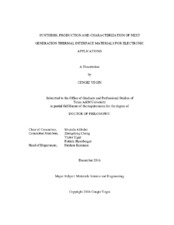| dc.contributor.advisor | Akbulut, Mustafa | |
| dc.creator | Yegin, Cengiz | |
| dc.date.accessioned | 2017-03-02T16:49:07Z | |
| dc.date.available | 2018-12-01T07:20:51Z | |
| dc.date.created | 2016-12 | |
| dc.date.issued | 2016-12-08 | |
| dc.date.submitted | December 2016 | |
| dc.identifier.uri | https://hdl.handle.net/1969.1/159049 | |
| dc.description.abstract | The inefficient dissipation of heat is a crucial problem that limits the reliability and performance of all electronic systems. As electronic devices get smaller and more powerful, and moving components of machinery operate at higher speeds, the need for better thermal management strategies is becoming increasingly important. Heat removal during the operation of electronic, electrochemical, and mechanical devices is facilitated by high-performance thermal interface materials (TIMs), which are utilized to couple devices to heat sinks. Herein, we report a new class of TIMs involving the chemical integration of boron nitride nanosheets (BNNS), soft organic linkers, and a metal matrix - which are prepared by chemisorption coupled electrodeposition approach. Thermal and mechanical characterization of the copper-based hybrid nanocomposites involving thiosemicarbazide demonstrates bulk thermal conductivities ranging from 211 to 277 W/(m.K), which are very high considering their relatively low elastic modulus values on the order of 15 to 30 GPa. The synergistic combination of these properties leads to the lowest measured total thermal resistivity to date for a TIM with a typical bondline thickness of 30-50 µm: 0.38 to 0.56 mm^2.K/W. Moreover, its coefficient of thermal expansion (CTE) is 11 ppm/K, forming a mediation zone with a low thermally-induced axial stress due to its close proximity to the CTE of most coupling surfaces needing thermal management. Furthermore, preliminary electrochemical tests revealed that the presence of organic ligands and BNNS in the hybrid nanocomposite TIMs improves the corrosion protection behavior of the TIMs by nearly 72%.
Further analysis of the hybrid nanocomposite TIMs included the replacement of thiosemicarbazide with various organic ligands and the replacement of copper matrix with silver. Compared to all the ligands that were used in copper-based hybrid nanocomposites, the most promising thermal and mechanical test results were obtained from thiosemicarbazide. On the other hand, the best silver-based nanocomposite TIM was determined to be the one involving the ligand 2-mercapto-5-benzimidazolecarboxylic acid, in which the thermal conductivity was near 360 W/m.K, and elastic modulus and hardness were about 35 GPa and 0.25 GPa, respectively. The promising results indicate that metal-inorganic-organic nanocomposite TIMs can be great alternatives to currently used TIMs in the market. | en |
| dc.format.mimetype | application/pdf | |
| dc.language.iso | en | |
| dc.subject | Thermal Interface Materials | en |
| dc.subject | Ultra Low Thermal Resistance | en |
| dc.subject | Enhanced Thermal Conductivity | en |
| dc.subject | Mechanically Compliant | en |
| dc.title | Synthesis, Production and Characterization of Next Generation Thermal Interface Materials for Electronic Applications | en |
| dc.type | Thesis | en |
| thesis.degree.department | Materials Science and Engineering | en |
| thesis.degree.discipline | Materials Science and Engineering | en |
| thesis.degree.grantor | Texas A & M University | en |
| thesis.degree.name | Doctor of Philosophy | en |
| thesis.degree.level | Doctoral | en |
| dc.contributor.committeeMember | Cheng, Zhengdong | |
| dc.contributor.committeeMember | Ugaz, Victor | |
| dc.contributor.committeeMember | Shamberger, Patrick | |
| dc.type.material | text | en |
| dc.date.updated | 2017-03-02T16:49:07Z | |
| local.embargo.terms | 2018-12-01 | |
| local.etdauthor.orcid | 0000-0002-9974-5541 | |


